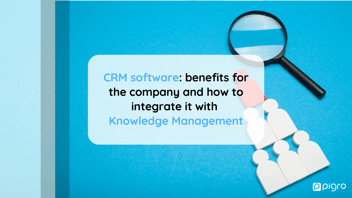An information management system, as explained in previous articles, is the infrastructure in the company that allows you to manage information, collecting data from multiple channels, throughout the business lifecycle, and turning it into information that can be used to make decisions.
If you are reading this article, you will probably be interested in evaluating a Knowledge Management System. Contact a Pigro expert for a custom solution, or read on to learn more.
The information in the knowledge base and the importance of Knowledge Management Systems
The company's Knowledge Base is the intellectual capital of the company and, as we never tire of repeating, it is essential to implement a system to manage it, in order to facilitate access to knowledge, essential to carry out any work activity.
Once we understand its importance, we need to understand how to organize and manage all the information it contains. The main knowledge management system benefits consist of the fact that it can collect all knowledge (explicit and tacit) and provide centralized access to it so that it is always available.
However, in order to choose software that allows us to do this with the least number of resources, it is good to know some basic features that will save us time and money.

How to Choose the Right Knowledge Management System tools
When considering implementing a knowledge management system that suits your needs, there are some main factors to take into account:
1) User experience:
The first and most immediate feature to consider is the type of interface that the Knowledge Management system has: through it, we will interact and search for the information we need, for this reason, it is important that it is easy to use, to offer concrete support to the agents.
A Knowledge Management software that allows integration with different programs and applications is certainly more convenient than one that forces us to change the way we work.
Furthermore, software like Pigro has different types of user experience, such as a portal interface (useful for employees) or a chatbot (which can be integrated into any website and also used by end customers), so it can be used on different occasions and by different users.
2) Technological infrastructure:
Second, but not least, there is the technology used by the Knowledge Management system.
Today, more and more Knowledge Management solutions are based on artificial intelligence, with numerous advantages both in the construction phase (e.g. importation of the knowledge base) and in the search for content, which can be based on semantics or statistics.
The solution offered by Pigro is based on a proprietary Artificial Intelligence algorithm, which minimizes the use of resources by the company in the implementation of the system. Pigro, in fact, automatically imports all the contents of the company's knowledge base and allows users to interrogate them in natural language, receiving the information in response.
The training phase of the system is fast and automatic, does not require rewriting or changes to the knowledge base to be imported and, thanks to statistical technology, is more accurate even in the output provided to the user.
3) Content Management:
The ability to automatically update content is another essential feature when it comes to Knowledge Management systems.
If our repositories are disorganized and chaotic, every time we need a piece of information, we'll have to worry about whether it's the latest available and updated version of the document that contains it.
With Pigro, the knowledge base is accessible from a single point of access and the system constantly updates the content so that any changes made to the documentation are recorded and you can quickly find the answers you need to do your job.
4) Data and analytics:
Finally, there is the ability to obtain data and statistics on knowledge base usage, which are useful to optimize resource utilization and ensure fluidity and consistency in the customer experience.
Most knowledge management systems have features like this that allow departments and top management to monitor knowledge base usage and understand how to improve both content accessibility and, consequently, employees' workflows.
Pigro provides these metrics and, thanks to Artificial Intelligence (AI), indicates knowledge gaps in the company's documentation so they can be filled by creating new content and sharing it across divisions.
Read also:
- How to integrate an information retrieval system into a business process
- What is information management and how to use it
Do you want more information on Pigro Knowledge Management solution? Contact us!



